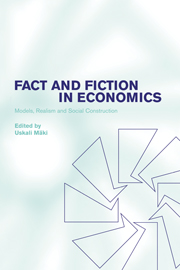Book contents
- Frontmatter
- Contents
- Notes on the contributors
- Preface
- I Introduction
- II Setting the scene
- III Economic models and economic reality
- 5 Credible worlds: the status of theoretical models in economics
- 6 The limits of causal order, from economics to physics
- 7 Econometrics and reality
- 8 Models, stories, and the economic world
- 9 Economic models and reality: the role of informal scientific methods
- 10 Truthlikeness and economic theories
- IV The constitution of economic reality
- V The institutions of economics
- Index
- References
6 - The limits of causal order, from economics to physics
Published online by Cambridge University Press: 22 September 2009
- Frontmatter
- Contents
- Notes on the contributors
- Preface
- I Introduction
- II Setting the scene
- III Economic models and economic reality
- 5 Credible worlds: the status of theoretical models in economics
- 6 The limits of causal order, from economics to physics
- 7 Econometrics and reality
- 8 Models, stories, and the economic world
- 9 Economic models and reality: the role of informal scientific methods
- 10 Truthlikeness and economic theories
- IV The constitution of economic reality
- V The institutions of economics
- Index
- References
Summary
Introduction
The topic that I will focus on here is not that of realism in science – i.e. how accurately can the sciences, including economics, represent the world – but rather the question of the range of science – how much of the world it can represent. The idea of a science unified and complete has been advocated throughout the history of thought, but the sciences have steadfastly resisted this kind of regimentation. They remain distinct and confined, and they continue to cover only very small patches of the world we live in. We may dream that the sciences will some day cover everything, but, I shall argue, that is not likely to be a dream that is even “in principle” achievable. The very ways we do our sciences when they are most successfully done confine them within limited domains. This is true, I believe, from the social sciences through the natural sciences and especially for fields like economics and physics that have embraced mathematics as their principal form for representation.
When I talk of “science” here I am assuming the positivist idea of exact science: science as a body of explicit knowledge, systematically organized, from which precise and unambiguous claims can be rigorously derived. It is my underlying view that it is this quite reasonable demand that scientific claims be precise and unambiguous that imposes limits on how far the sciences can stretch, for not much of the world lends itself to this kind of description.
- Type
- Chapter
- Information
- Fact and Fiction in EconomicsModels, Realism and Social Construction, pp. 137 - 151Publisher: Cambridge University PressPrint publication year: 2002
References
- 19
- Cited by



